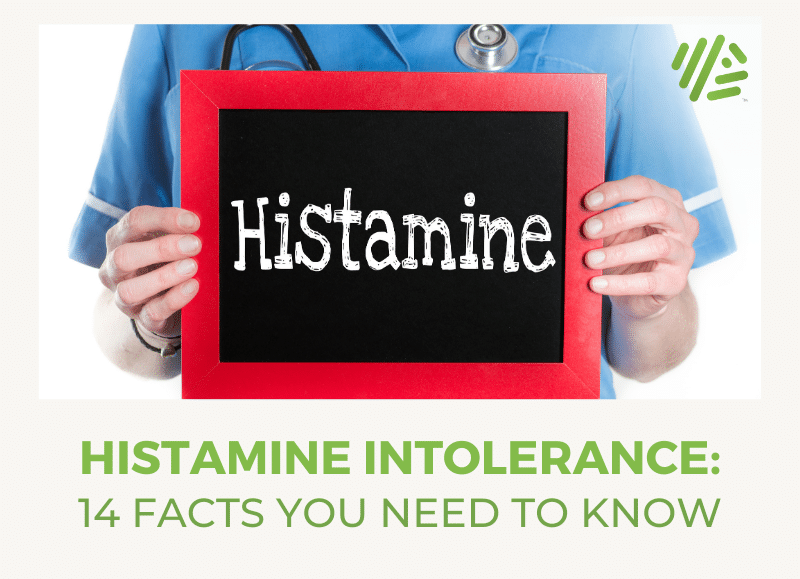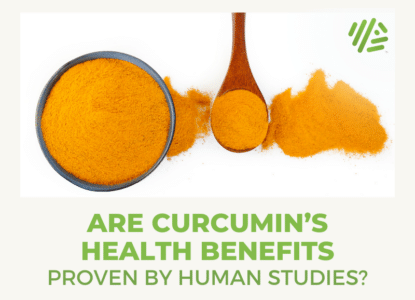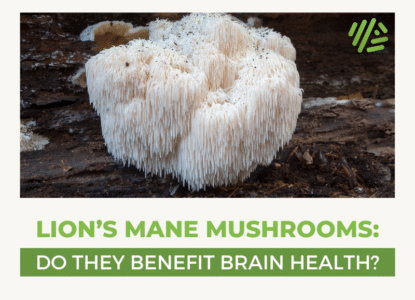Histamine Intolerance: 14 Facts You Need to Know
Genes Mentioned

Contents
- #1. Histamine is a neurotransmitter
- #2. Histamine is released from mast cells
- #3. Excess histamine causes food poisoning
- #4. One percent of people suffer from histamine intolerance
- #5. Seasonal allergies can contribute to histamine intolerance
- #6. Histamine intolerance has a genetic component
- #7. Histamine intolerance can cause gut issues
- #8. Our microbiome can produce histamine
- #9. NSAIDs may aggravate histamine intolerance
- #10. Alcohol makes histamine intolerance worse
- #11. All food has histamine
- #12. Freshness of food is key
- #13. Elimination diets can be easier than you think
- #14. Stress can histamine intolerance worse
- Key Takeaways
As evidenced by this excellent paper in the American Journal of Clinical Nutrition, histamine intolerance is a condition that is starting to gain more awareness in the medical community.
It’s a problem that can seriously degrade anyone’s quality of life. Based on my experience with histamine issues, and after our research team spent over 100 hours combing through all the relevant peer reviewed studies on histamine and histamine metabolism, there are 14 things we’d like you to know about this condition.
It is our team’s hope that the information in this post will help anyone battling through this difficult time, but before we get started, some words of optimism.
First, it is possible to get a handle on histamine intolerance, it may not be easy, but with a personalized approach it can be conquered.
Next, and this is crucially important – do not fear the fridge! Histamine intolerance is bigger than food. Ultra restrictive diets with 100 foods to avoid aren’t the solution long term. In order to be healthy, you must eat. This doesn’t mean that low histamine diets can’t help, but food isn’t the whole story, there are multiple factors that contribute to histamine overload.
With those preliminary notes out of the way, let’s get into the list.

Get Started With Personalized Nutrition
Gene Food uses a proprietary algorithm to divide people into one of twenty diet types based on genetics. We score for cholesterol and sterol hyperabsorption, MTHFR status, histamine clearance, carbohydrate tolerance, and more. Where do you fit?
#1. Histamine is a neurotransmitter
Yes, that is correct, no one is actually “histamine intolerant,” we all need histamine, it’s an essential neurotransmitter. 1 However, as with anything, too much of a good thing can cause problems. Each of us has a histamine bucket. As our bodies make histamine, and as we ingest it in food, it is cleared by an enzyme known as diamine oxidase. When more histamine accumulates than our diamine oxidase levels can handle, symptoms begin which leads to the condition known as “histamine intolerance.”
#2. Histamine is released from mast cells
We can eat histamine, our brains use histamine, and the immune system also releases histamine from a special class of cells, called mast cells. Think of mast cells as the military sentinels of the immune system.
When these cells see a foreign invader, like a virus, or allergen, they react by “degranulating” and releasing cytokines that can seek out and kill the invader. Histamine is released from mast cells as part of this process. It acts as a vasodilator to facilitate blood flow to injury sites in the body.
The key thing to understand when experiencing histamine intolerance is that mast cells can become chronically irritated, causing the near constant release of histamine. We need mast cells for a properly functioning immune system, but they also need rest. When bacteria, an environmental toxin, or an allergy continuously trigger mast cells, the resulting cytokine activity can start to cause tissue damage. Increased levels of tissue damage leads to chronic inflammation.
Based on the commonly reported symptoms of histamine intolerance, it probably won’t come as a big surprise that mast cells are found in greatest numbers at the site of mucous membranes: skin, nose, throat, gut, lungs, and bladder.
In a very real sense, the quest to get over histamine intolerance is the quest to discover what is irritating the immune system and to remove it from the equation. Histamine intolerance can also be misdiagnosed as mast cell activation disorder.
#3. Excess histamine causes food poisoning
You may have heard the expression – “the dose makes the poison.” If you have one bourbon, you have a great time. If you have the whole bottle, you end up in the hospital. The same principle applies to dietary histamine. At a high enough dose, every one of us is histamine intolerant, as large doses of histamine cause food poisoning.
#4. One percent of people suffer from histamine intolerance
The American Journal of Clinical Nutrition estimates that 1% of the population suffers from histamine intolerance and 80% of those patients are middle-aged. Because the symptoms of histamine intolerance overlap with many other conditions, struggles with histamine often go undiagnosed. One possible way to catch a histamine intolerance is through inspection of a bug bite. Weird? Maybe, but when a “normal” bug bite swells out of control, it could be a sign that histamine levels aren’t where they should be in the body. If this is a normal occurance for someone, visiting a primary care physician might be a good next step to explore.
#5. Seasonal allergies can contribute to histamine intolerance
This factor is not discussed as much as it should be. Food gets all the attention, but histamine intolerance goes well beyond food. Allergy to the environment triggers the immune system to produce histamine, which starts to fill the histamine bucket.
Consider this quote from the American Journal of Clinical Nutrition:
Underlying conditions for increased availability [of histamine] may be an endogenous histamine overproduction caused by allergies…
The production of histamine by air-borne allergens can unknowingly take up a large portion of the histamine bucket, leaving reduced wiggle room with food. This means that location alone can be a cause of histamine intolerance.
To this point, Dr. Janice Joneja wrote an excellent blog on the subject of histamine that everyone should read. This quote, in particular, stands out:
A person with histamine intolerance will typically experience a constant fluctuation in the signs and symptoms of histamine excess in response to changing conditions. For example, when a person is experiencing allergy to air-borne allergens such as seasonal pollens, the histamine released in the allergic response alone might put them into the symptom range. In such a case, avoiding histamine-associated foods will no longer relieve their symptoms because their total level of histamine will remain above their limit of tolerance. This explains the observation that during their “pollen allergy season” many people find themselves reacting to foods (usually histamine-rich foods) that they could normally eat with impunity.
#6. Histamine intolerance has a genetic component
An enzyme called diamine oxidase is responsible for cleaning up histamine in the gut. 2 The AOC1 genes are coded to make this important enzyme, but not everyone is born with the same enzyme activity, which makes some of us genetically more susceptible for developing histamine intolerance.
So as not to confuse the DAO enzyme with the DAO gene (which many online forums do) take a look at Aaron’s post: You say DAO, I say DAAO.
DAO breaks down “free histamine,” like the histamine found in the gut, while HNMT, another histamine gene, processes histamine in the cell.
Variants in the AOC1 genes have been associated with reduced DAO activity. For example, this Italian study found that 10 out of 14 patients with histamine intolerance had very low levels of serum DAO.
#7. Histamine intolerance can cause gut issues
Mast cells reside in large numbers in the gut, so a chronic allergic response paired with an inability to clear the histamine (due to reduced DAO) will irritate the gut over time.
Aaron’s research indicates that histamine issues often coincide with gut problems. Histamine, when chronically elevated in the gut, can cause an increase in zonulin, which is a protein shown to break apart the epithelial wall; the lining that keeps the contents of the gut from entering the bloodstream.
For more on gut health and histamine, take a look at the podcast episode we did on the subject.
Decreased DAO levels are linked to a number of inflammatory bowel conditions, including Crohn’s disease and ulcerative colitis. This small study, which evaluated tissue samples from the intestine of 20 patients struggling with Crohn’s, found that all of the patients had very low levels of DAO.
To make matters worse, many fermented foods, marketed for “gut repair,” are very high in histamine. Collagen is a bad one.
#8. Our microbiome can produce histamine
Changes to the flora in our guts may be a contributing factor to histamine intolerance, which is why some of us develop histamine problems after a severe infection and multiple rounds of antibiotics.
Small scale studies have shown that the microbiomes of those with histamine intolerance are altered in noticeable ways. Again, the studies aren’t enormous, but patients with histamine intolerance have been found to have elevated levels of Proteobacteria above what is considered normal. Proteobacteria are a type of microbe found commonly in disease states.
Further, healthy microbes in the gut, like many Bifidobacterium species can degrade histamine, while other unhealthy microbes, such as Escherichia, can produce histamine. 3
#9. NSAIDs may aggravate histamine intolerance
Certain variants in the AOC1 genes are associated not only with lower levels of diamine oxidase, but with NSAID allergy as well. The SNP in question is rs10156191.
Carriers of the T allele, which is also linked to lower DAO activity, are likely to have a hypersensitive reaction to NSAID drugs.
#10. Alcohol makes histamine intolerance worse
As we’ve established, one factor in the body’s ability to deal with histamine is genetic, however, lifestyle also plays an important role.
You may have read that alcohol degrades DAO activity, which further worsens histamine issues. This is a widely reported “fact” on the internet, but the evidence is limited. Having said that, drinking alcohol is not good for you under normal circumstances, but it’s especially bad if you are suffering from histamine intolerance.
Most alcohol, and especially beer and wine, is fermented and very high in histamine. If you’re looking for a drink to quickly fill and overflow the histamine bucket, it’s alcohol of any kind. Some people report success sticking to clear liquor rather than beers, wines, and liquors with more additives.
This study, which appeared in the Journal Allergy and Asthma Proceedings, evaluated the histamine levels of 28 wine intolerant subjects before and after drinking red wine. Within 30 minutes, 22 of the subjects saw their histamine levels sky rocket.

Get Started With Personalized Nutrition
Gene Food uses a proprietary algorithm to divide people into one of twenty diet types based on genetics. We score for cholesterol and sterol hyperabsorption, MTHFR status, histamine clearance, carbohydrate tolerance, and more. Where do you fit?
#11. All food has histamine
In some cases, especially when medical supervision is present, a low histamine diet can be just what the doctor ordered to help curb a problem with histamine intolerance. However, it’s important to recognize that almost all food has some histamine. Known as a “biogenic amine” histamine in food accumulates the longer food sits out, and is especially bad in aged and fermented foods. However, it is impossible to completely avoid dietary histamine.
#12. Freshness of food is key
A glass of wine at the end of the day is like a cup of coffee in the morning for some people. Necessary. So it may be upsetting to hear that red wine is a no go for those with unbalanced histamine levels. But why?? In part because it’s aged and fermented. Though these factors are what makes it delicious, it is also what makes it high in histamine. The same is true for:
- Leftovers
- Smoked meat and fish
- Deli meat
- Aged cheese
- Meal prep services
- Fish that is not fresh
- Avocado and banana
Any food given time to ripen or age will only increase in histamine the longer it sits out. Keeping an eye on the freshness of food is key if your goal is to defeat histamine intolerance.
#13. Elimination diets can be easier than you think
If the thought of cutting out 100 foods to adhere to a low histamine diet scares you, you’re not alone.
Even the list cited above seems rather large, doesn’t it? Well, if you want to experiment with food triggers, and go low histamine, start by cutting out the least nutrient dense foods and move on from there.
What does this look like?
It means ditching the condiments. Pickles, sauerkraut, ketchup, salsa. These foods are notoriously high in histamine, and although they are tasty, they confer very little in the way of nutrient density.
Next, eliminate alcohol, especially the heavily fermented variations. Additionally, and unfortunately, no more cold cuts, leftovers, aged cheese, and smoked salmon.
Oh, and take a break from coffee and tea. They are both histamine liberators, but more simply, they contain caffeine which increases cortisol. Most people with histamine issues need to balance stress as a first priority because…
#14. Stress can histamine intolerance worse
At the beginning of this post,the role that mast cells play in histamine intolerance was discussed. There are a myriad of factors that can trigger mast cells, but stress is one of them.
High stress environments will make a case of histamine intolerance worse. Consider this review by world renowned mast cell expert Dr. Theoharis Theoharides in which he discusses the stress response and its impact on the immune system.
For interested readers, we interviewed Dr. Theoharides on the podcast last year.
Key Takeaways
- Histamine intolerance is multifactorial – starting to react to food is a sign that some other upstream factor is amiss.
- Physical location plays a role in histamine intolerance.
- Ruling out mold toxicity and examining the health of the microbiome are worthwhile exercises when histamine intolerance strikes.
- Alcohol, antibiotics and NSAID drugs are kryptonite for those suffering from histamine intolerance.
- Some people are at a genetic disadvantage in clearing histamine.




You have clearly never had mold poisoning. Lucky you. The single most important step to healing is avoidance — and it is not vague. It is a smart and deliberate choice in avoiding the top five species that can trigger autoimmune disease, COPD and worse. A step that takes some years or even decades in order to regain health. Perhaps you can rethink calling this absolute necessity a ‘mentality’. Do you think leaving all my belongings and home of 30 years behind was easy? Coughing up blood at Bellevue hospital due to stachybotrys exposure is not something I wish on anyone. I cannot walk into a water damaged building without feeling like my skin is on fire. and ending the day with a migraine. Finding a mold-free place in America is difficult enough, let alone when compounded by chemically-ridden building materials. My strict ‘mentality’ is directly responsible for the lessening of my histamine issues and regaining my health. Walk a mile in someone else’s shoes before you judge.
Kerry, I think you misunderstood my comments. I have total sympathy for those suffering from mold toxicity, and I was not suggesting avoidance isn’t necessary. However, the locations effect groups, in some cases, can go overboard in my opinion. That is all I am saying.
I recently started noticing that my body itches during my period, i also get a blocked nose and some sneezing. Google says it’s because of histamine release so on my next period i will try to avoid dairy and gluten. I already don’t eat a lot of meat. I hope it will help.
About three months ago I developed bad itching on the back of my scalp. I actually was convinced I had lice but could not find any evidence of them. Then a month later I started to develop 2 hives just below my back hairline. After online research I found info on chronic idiopathic urticaria (CIU). Basically in an unknown reason from chronic hives. It’s also thought that histamine can play a role. A couple months before this all started I was eating quite a bit of grapes daily. My theory is just got the ball rolling. I’ve also been a user of ibuprofen the past few years but only when needed. Well I gave up grapes and fish and cheeses and have started taking clatitin daily. I’m 20 days in. The hives have improved but still there. The irritation is nowhere what it was but still some. I have a physical schedule for Jan 7 I will see what my new doctor thinks. I’m 60 and never had allergy issues. This has really sucked.
Hello.
Long time ago I had a girfriend who has psoriasis, and its main manifestation for her was in the back of her scalp.
You may actually being allergic/intolerant to salycilates, independently of whether you (also) have issues with amines.
Where did chocolate fit/not fit into this? I am limiting but not excluding this (only four months in after a perfect storm of allergies from boxes/NSAIDS/lack of exercise, etc. Have given up tea, tomato (really hard), yogurt, wine, and citrus. Working with a naturopath on gut health part. Only symptom is hives. Thanks
Thanks John for this incredibly helpful and well written site. It’s helped me make sense of a life long struggle with allergies, and all sorts of psycho somatic conditions that defy logic or indeed most doctors’ know how. The bizarre paradox has just hit me that by trying to deal with what I suspected was Candida by taking a ton of kefir everyday and high protein diet, I have probably made things worse given the fermented foods/high histamine levels issue. I’ll chanfe to a different means of getting probiotics into me.
Any thoughts on what I can do to get protein in me without increasing histamine levels? I exercise a lot and will struggle without it. Very grateful if you have advice. Again, many thanks for the site which has helped me make sense of a very confusing picture.
Life Extension GI Bifido Balance specifies that it contains Longum BB536, the specific strain referenced in the article.
Very interesting article. How do you take your supplements, and which did you start with? I am being seen by a functional MD. She and my allergist both think that histamine intolerance is one of my issues. Also diagnosed with Lyme co-infections, candida is present in my gut, but no good gut bacteria is, I have had mold exposure and at least one mycotoxin is present based on one of the labs you mentioned, I had heavy metal (uranium) exposure, multiple food allergies, oral allergy syndrome from serious environmental allergies, gluten intolerance, a history of cancer and osteoporosis. I am not taking anything yet, except calcium/vitamin D since stopping dairy, but they are lining me up to take lots of things once the last of all her baseline tests are done. I can’t take the DAO because I have a pork allergy. The 2 recommended Lyme supplements each have one ingredient I’m allergic to, and they don’t think my gut can handle the antibiotic in the shape it’s in now. So they are going to have to wing it on fighting Lyme. I am already fairly close to a low-histamine diet, I don’t drink, and I don’t exercise to exertion. But where I live, I am allergic to everything. And I’m nervous to try the supplements, because right now, seem to react to even safe foods. The allergist didn’t diagnose MCAS, but said it’s possible. Where did you start with all these supplements, and how quickly did you add in each thing? Thanks.
Thanks for your article. My question is that Histamine intolerance persons can use whole food vitamins or natural source derived vitamins because manufactures using yeast and probiotics.Some companies add extra probiotic in whole food vitamins. I would like to know your opinion about this subject
Oh my gosh! I visited Dublin/Malahide last November. I thought I was going to die by the time got home. The mold is terrible! I was sick for 3 weeks.
Thanks for all your good information; I have found that all the supplements that help the histamine issue cause problems with my eyes. Any thoughts on this??
Thanks so much
Lisa
I also live in Austin and have for 24 years, I moved to Texas 44 yrs. ago from CA. and soon developed allergies. I now have year round allergies, sinus pressure pain, nasal drip and mainly lots of mucus that causes me to cough all the time. I am really allergic to the great Central Texas mold….Alternaria! Seasonal with Ragweed, Grasses, Pigweed, Fall Elm and our wonderful winter Cedar Fever! All these trigger my migraines…ugh!
I spent a year with an infectious disease doctor because I developed non-infectious TB….my lungs became infected because of the allergies and constant mucus, they think. I spent a year on a strong antibiotic cocktail that I know destroyed my gut bacteria and caused an imbalance.
Because alcohol is a migraine trigger, I started researching and discovered the histamine connection. Now I am in the process of learning more. The other day I had a salad with spinach, tomatoes and avocado, that night I coughed on and off all night long because of the mucus and had a terrible migraine. Yesterday I ate none of the high histamine foods and have not coughed. I still have muscus and some sinus pain/congestion because of all the rain we are getting. I do much better when we are in a drought.
I am still experimenting, but appreciate what you have written to give me a better way to cope. I threaten my husband every day that I am moving to an area with better climate, but my kids and grandkids live here and I cannot leave them, so I will try to live with Central Texas allergens.
I am open to any suggestions. Thanks, Jan
Sorry for your condition, its hard to move and leave family behind but maybe they can visit? Also what about sweets and sugar..are you avoiding them because I find that I get instant congestion when I have sugary things
I don’t see that Solgar LP229V probiotic anywhere – Not even on the solgar website. Do you have any others you recommend?
I am going to also chime in here. As someone with MCAS/EDS/Dysautonomia, I can tell you that thr docs who study MCAS or Masto regularly lecture against using tryptase as a diagnostic tool for MCAS. It will be normal unless one is actively in the middle of an “attack”. A 24 hour urine histamine is a much more reliable test.
Final comment – I noticed that you interviewed Dr Nathan. I’m certain that he will agree with everything I wrote above. Ask him.
And since you’re interested in genetics, look up the HLADR test (Shoemaker and colleagues) which shows which people will be affected by mold toxins and which are not. About 24% of the population can not clear the mold toxins, so they build up in their bodies.
I never comment on posts like these but in this case there was something so incredibly wrong that I couldn’t let it go. You wrote that “becoming phobic of place after place due to an often vague notion of “mold toxins” is I believe a sickness mentality”. And that the “extreme mold avoidance” lifestyle, is in my view, just another high histamine food list – an unsustainable lifestyle that prevents full participation in, and enjoyment of life”.
“Sickness mentality” !? So you’re basically saying that “it’s all in their head”. This is wrong, offensive, and shows a profound lack of understanding of how serious mold illness can be. Someone who is recovering form mold illness (CIRS – Chronic Inflammatory Response Syndrome) can be made VERY sick for days, weeks, or even months just by spending a few minutes in a moldy building. This can, and has been, proven by measuring the individuals C4a before and after exposure to a moldy building. This method has been used in court to prove that the individuals sickness was caused by a given building. I suggest that you read the peer reviewed scientific literature by Dr Ritchie Shoemaker and his colleagues.
Richard,
I am NOT talking about moldy buildings. My reference there was to avoidance of places (cities, not buildings). I understand that mold toxicity is a real issue for many people, but in my view, the locations effect groups (who constantly move from city to city, often in RVs) can take things a bit far. Having said that, it’s up to each individual to do what they need to to get well and I do think physical location plays big a role in health. I respect anyone trying to figure things out.
Re: Dr Nathan and Dr. Shoemaker. I am familiar with Dr. Shoemaker’s work and I have spoken with Dr. Nathan. It is his view that buildings make people ill, not locations (cities) which again is what I was referring to in the quote you cite above.
Re: the mold genes, our view is that evidence surrounding the HLA genotypes is lacking: https://www.mygenefood.com/mold-genes/
Life is miserable without red wine, yogurt, and cheese. Already gluten free, vegetarian, no tomatoes or eggplant. So tired of my allowable foods. Very tight box already so I’ll just have to take OTC allergy meds….
Thank you for this great article. I have just discovered Histamine Intolerance as my potential nemesis….and was getting discouraged as watching my foods wasn’t enough. I still have many symptoms (maybe not as bad, but, bad enough). But, your article gave me the confidence that just my diet isn’t enough….I live in an area with many allergans plus I have some hormonal stuff going on that makes this a viscous circle! But, thank you for the great article, it helps me know more about the complexity of all of this!
Thanks for such a comforting article. I “fixed” my HIT with exactly the extreme diet you mentioned but have since been adding things back in because it definitely is not sustainable! I recently started taking BioDisrupt from RN for biofilms (Lyme). The ingredients are cranberry extract, Berberine, rosemary extract, and peppermint oil powder. Would any of this trigger histamine release? I have returned to abruptly awakening in the middle of the night and my skins feels prickly. Thanks for any information you can give me!
I am having a similar episode taking EDTA nasal spray as part of my mold treatment. I also have a history of chronic lyme and co infections. I think it disrupted a bunch of biofilms and my histamine bucket just over flowed because of the toxins it releases. I need to get my toxin levels down before doing anything that causes die off now. I would be more suspicious that you are having a histamine reaction to the die off than to the supplement. Just my opinion based on my experiences though. It is important to go slow with that stuff and support detox depending on how fast you clear toxins. I hope you are feeling better.
Just to let all know that I read that NAC supplement blocks DAO production. I was taking it for about 3 or 4 months before I realized I was having a histamine intolerance problem. After I stopped taking it my histamine intolerance got better.